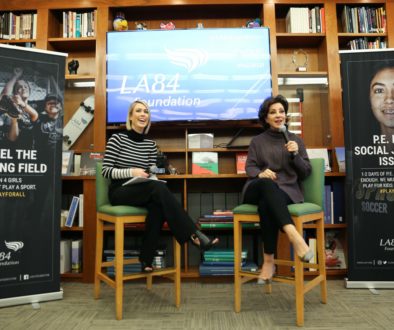SL Interview: Keith O’Brien’s Year in Kentucky High School Basketball
The season-in-the-life genre has yielded several classic tales about youth sports: Buzz Bissinger’s “Friday Night Lights,” Madeleine Blais’ “In These Girls, Hope Is a Muscle,” John Feinstein’s “A Season on the Brink.” These writers immersed themselves in the culture of the teams they were following and, perhaps more importantly, in the communities that obsessively supported these teams. What they discovered was simultaneously triumphant and troubling.
In “Outside Shot: Big Dreams, Hard Times, and One County’s Quest for Basketball Greatness” (St. Martin’s Press), journalist Keith O’Brien journeyed to rural Kentucky to follow the fortunes of the boys basketball team of Scott County High School during the 2009-10 season. Like Bissinger, Blais and Feinstein before him, O’Brien immersed himself in a culture and a community that to outsiders might seem totally alien. The result is equally triumphant and troubling.
Wrote reviewer Bill Littlefield in the Boston Globe: “‘Outside Shot’ is being compared to the spectacularly successful ‘Friday Night Lights’. . . . The comparison is legitimate in that both books are about young athletes celebrated in their communities who see sports as a path to a new life, and both communities are made up of the quietly desperate who get more excited about high school sports than they do about anything else.”
A former reporter with the New Orleans Times-Picayune, O’Brien left his staff job at the Boston Globe to research and write “Outside Shot.” SportsLetter interviewed him by phone from his home in New Orleans.
— David Davis
SportsLetter: What drew you to this story and when did you decide: this is worthy of a book?
Keith O’Brien: For quite some time I had been looking for a book idea and, specifically, a sports book that would be more than just about sports. Something that would get at who we are, that would get at American culture in the twenty-first century. In the winter of 2008-09 I hit upon that Kentucky essentially was the last state that had single-class basketball in high school. That means that every spring in Kentucky 270 high schools make the post-season – every single one of them. There’s no breakdown in division based on the size of the school or the wealth of the school or the location of the school. There’s no 5A, 4A, 3A, and so on. There’s one state tournament. There’s one state title.
The 270 teams get whittled down to 16 teams – one from each region in the state – that go to the Rupp Arena [in Lexington]. When the teams get there, these boys and men will literally weep at the idea that they’ve made it. They’ll get down on their knees and kiss the hardwood. And, 20,000 fans will fill Rupp Arena for high school basketball games at noon on a Wednesday.
The more I read about it, the more I learned about it, I became fascinated by it. Whether it was true or not, these coaches and these boys believed that making it to Rupp would change their lives. That was compelling.
SL: It sounds like Kentucky’s high school tournament today is like Indiana’s was back in the day. Is that a fair comparison?
KOB: That’s right. When most people think about single-class basketball, they think about Indiana and the story popularized by the movie “Hoosiers.” The reality is over 15 years ago Indiana scrapped its single-class basketball tournament. They did so because there were complaints among smaller schools that it wasn’t fair. And you know what? It probably isn’t. It probably isn’t fair that you’ve got to play for the state title against a school with 3,000 kids when your school has 300. So, in the mid-to-late 1990s, there was a big push to end single-class basketball in Indiana. I believe there now are three classes of basketball in Indiana.
In Kentucky, though, they don’t care so much about fairness. They want to know who’s best, plain and simple. They like that mathematical simplicity and purity.
Every 15 to 20 years in Kentucky there’s been a movement to do away with single-class basketball for the same reasons that Indiana did away with it. And, right when that happens, every 15 to 20 years, some small school from the hinterlands of the coal country wins the state title, and everyone says, “Nope. We’ve got the greatest system in the world here. We’re never going to change it.”
SL: How did you settle on Scott County High School as the team to follow for the season?
KOB: There’s a right way and there’s a wrong way to tell every story. And, a really wrong way to tell this kind of story would be to say, “Well, I’m going to write a chapter about this town, a chapter about this place, and a chapter about this school because basketball matters all across Kentucky.” But you don’t get very in-depth doing that, and you don’t get connected to the human stories doing that. I wanted one school, one season, full access.
For me to do that, I needed to have the school be a vehicle to tell the story and be reflective of the Kentucky experience. I wanted a public school. I wanted a county school. I wanted a community where basketball mattered with a capital M. I wanted a team that was going to be competitive. I couldn’t have a school that was going to go 7-20. I don’t know what kind of book I could have written out of that.
Finally, the most important thing for this story was, I wanted full access. I needed that complete access to the program. I wanted to be there for everything: on the bus, in the locker room, at practice, in the classrooms. I threw this idea out to several schools that I felt could potentially meet my criteria in the spring of 2009. I met with multiple coaches and athletic directors to get a feel for whether or not they would be willing to give me this kind of access.
In the end, Scott County was the only one who was willing to give me the access I wanted — which worked out really great because Scott County was the school I wanted. They’re the most dominant basketball program in the state of Kentucky in the last 20 years. They are your classic rural powerhouse, led by an iconic coach, Billy Hicks, who’s eclipsed 800 victories since the book was completed. He’s well on his way to 900.
SL: You moved your family to Kentucky to write the book. Was that a difficult decision?
KOB: It was difficult decision simply from a logistical and financial standpoint: renting a house and having that cost for the time we were there. But, no, it wasn’t something I waffled on. I was in that school every day for the six, seven, eight months I was there, and if I was going to do that, I wanted to be two miles away. To have that experience only enhanced my perspective of what it was like to live in Scott County.
SL: How would you describe the community?
KOB: It’s a very rural county, with about 44,000 people and, effectively, one city: the town of Georgetown, which has about half the county’s population. It’s about a 30-minute drive to Lexington, but it remains a very rural enclave.
That being said, it is a county in transition. In the last 20 years, Toyota opened a factory there, its first manufacturing plant in the entire U.S. That brought a lot of money into the county, which until then had been a primarily agricultural county. It also brought a lot of change — some tract homes, some outsiders, neither of which were all that welcome. There’s been a lot of tension about these changes that have taken root there.
For me, coming from Boston, it is country. The house my wife and I rented was on the backside of a 15-acre horse farm. We were awakened in the morning by the sound of a donkey braying down the hill.
SL: When people think about Kentucky hoops, they think of Adolph Rupp and the racism of that era. How would you describe race relations in Scott County today?
KOB: Billy Hicks’ team was roughly half-black, half-white, and harmonious. Two of the stars of the team and main characters of “Outside Shot” — Dakotah Euton, who is white, and Chad Jackson, who is black — were best friends. Inside the locker room, I never saw anything remotely approaching prejudice.
In Scott County at large, that prejudice exists, like it does in any white-majority, rural community. Black students were a very small minority in the halls of Scott County High School. Students reported, in surveys, race-related arguments. The winter I was there, in 2009-10, the rise of the Tea Party happened, not just in Kentucky, but across the country. You had parents who refused to let their children watch a President Obama address in the high school. That was a reality. It was something that the basketball players who were black faced, whether it was overt racism or just the kind of silent prejudice that persists in many American communities.
SL: The coach, Billy Hicks, and the players seemed to be opposites – old school, new school — but they rallied together for a successful season. What did you think of the way Coach Hicks handled his team?
KOB: One of the ironies that I noted while I was there was many of the basketball families had moved to Scott County just so that their sons could play for Billy Hicks, wear the Scott County jersey, get success and attention from college recruiters, and get all the things that parents of child-athletes want. And yet, these kids are in the locker room with a coach who has, at that point, nearly 800 wins, and they’re doubting him and his knowledge of the game.
Billy Hicks is not only one of the most successful high school basketball coaches in Kentucky, he’s one of the most successful high school basketball coaches in the country. His teams over the years have a calling-card style of play: an all-out, full-court press defensive assault, which would lead to fast breaks and high scoring outcomes. I know that Coach Hicks had a lot of frustration that season because many of the kids on the team had not come up in his system. He was having to break habits they had acquired elsewhere – in most cases, on the AAU circuit.
SL: What was Coach Hicks’ opinion of the AAU system in youth basketball?
KOB: One complaint that not only Coach Hicks had, but coaches across Kentucky that I spoke with had, was AAU basketball has made losing acceptable. If you are a child today playing basketball and you have any skills whatsoever, you play AAU ball all summer. You go from tournament to tournament to tournament, and you play six games a day sometimes. Most times it matters not whether your team wins. It just matters whether you look good while your team is playing.
High school coaches across the country are dealing with the fallout of that culture. I spoke to multiple coaches who said, “It doesn’t hurt kids today as much to lose, because they’re used to it.” As long as they look good and score their 20, so that the online scouting services maintain their rank and college recruiters still keep calling, that’s all that matters.
SL: You write that the Scott County team had many transfer students. How has that affected high school sports?
KOB: I think it’s a pervasive problem, and I think it’s one that is almost impossible to police for state athletic associations be it in California or New York or Kentucky or the state of Washington. It doesn’t matter where you are. The issue of recruiting or shopping around for that right program is pervasive.
There were multiple transfer players on Scott County who had come in from elsewhere. Each of them had very plausible reasons for transferring: their father lost his job, the family moved so that the father could be closer to work. These things happen to real families. And, Scott County is a public school. If you live in the district, you can go there. End of discussion. So, how are you to police that if you are the Kentucky high school athletic association?
And, how about when it comes to private schools, where you don’t have to live in a particular district? Parents can simply say, “I want to send my son or daughter to this school, and we’re going to pay for this.” How do you police that?
I think nearly every coach bends the rules, if not out-and-out breaks them. I think a great many parents do the same thing, when they shop around from school to school and say, “My son Johnny is 6-foot-5, and he would maybe like to come play with you next year. But he’s also looking at these three schools. What do you think about his chances of starting next year?” That conversation happens in gyms across America.
SL: You mentioned the ranking services that put a microscope on the athletes. What impact do these have in youth sports today?
KOB: These ranking services have existed for decades. As far back as the 1980s, there were these lonely sports fanatics who hung around gyms and produced pamphlets that 30 years ago were typed up on mimeograph sheets and bound with staples and sold for $20 to maybe l00 subscribers. Only a handful of people knew about them, most of them coaches. These days, the ranking services are big business. They’re no longer little pamphlets produced in basements and garages. They’re online, and they’re out there in the ether for everyone to devour. Everybody knows where Johnny is ranked among point guards in the state of Kentucky and among point guards in the entire country.
High school coaches complain about these sites because they know that their kids are concerned about where they’re ranked. And, who can fault them for that? Those rankings do have a legitimate impact on where the kids might go to college next year or in two years. That’s a reality. Of course a star shooting guard’s parents are going to be aware of where their son is ranked and what they’re saying about him online. They’re going to be in his ear about that, while the coach is maybe saying something completely different.
I can’t fault parents for that, and I can’t fault a kid for being concerned about where he’s ranked. What I can say is this: it seems we’ve reached a cultural low-point when we have created a big business out of ranking 13-year-old athletes and evaluating that kid’s skills. That’s a heckuva lot for a young boy or girl to bear. You wonder why we have crazed sports parents in this country? Well, ranking sites are one reason why.
SL: You describe a harrowing scene in the book: a real-life Fight Club, wherein the high-school boys gathered to beat up on each other. What was that like to witness?
KOB: One of the big pastimes was for them to go out on a Friday night, find a barn or a garage or a vacant lot or a cul-de-sac, line up their cars, and get out there and fight each other. When I learned about that, I wanted to go because part of what I was trying to capture was, what is it like to be 18 and live in a rural place like Scott County? What’s that like? What do you do with your time and what are your dreams?
The fact that one of the big pastimes was to go do this – and that they would post videos of their fights on YouTube and that they all had fantastic stories of the favorite fights they had seen – that’s fascinating.
SL: Was it just a way to pass another Friday night?
KOB: To me, the feeling wasn’t really boredom. It was more like desperation – this desperation to get out, to be somebody. It’s dark, after midnight, and they know they’re doing something that they shouldn’t be doing, that if the cops come by and find them they’ll arrest them – and they’re doing it anyway. As one of the key organizers of the fight described it to me, “It’s kind of like the feeling of freedom.”
SL: In the epilogue of the book, you note that several kids on the Scott County team received college scholarships and that several have stopped playing ball. How would you evaluate how they’re doing since graduating high school?
KOB: A couple of the players are having real success right now at Division I programs. Ge’Lawn Guyn is the backup point guard at the University of Cincinnati. He’ll have a good shot at being a starter there next year. Chad Jackson is starting at Northern Kentucky University, which is a new D-I program this year. He’s having a great season.
That said, this is Chad’s second stop since Scott County. A lot of the other players have had multiple stops or didn’t make the college ranks at all. The fact of the matter is it’s hard to make that leap. You can be a really talented high school athlete – whether you’re playing football, basketball or baseball – but making it at the next level is very difficult. A bounce pass that works just fine in Scott County doesn’t work so well in the Big East playing Syracuse. You have to have another level to your game.
If you’re 18 or 19-years-old and you’re pursuing your dreams, I believe you should do that. But I believe you should do that knowing how difficult it is and making sure that you’re using the college scholarship you landed to get an education. Chances are that’s what you’re going to be using in life, not the stat sheet you acquired playing sports. Unfortunately, a lot of these kids – and not just the kids in the book, but kids across the country – realize too late that the NBA dreams they’ve had for years are far-fetched. I think coaches are to blame for part of that, and certainly parents are to blame for part of that.
SL: What most surprised you in the experience of reporting and writing the book?
KOB: I was surprised by how beat down a lot of the teachers seemed, and how many of the teachers had seemed to capitulate to the students. Scott County is a school where a large number of the students – something like 40 percent – will not go on to college. That is a very American portrait. You could see in the classroom how that translated into student apathy. Their attitude was: why does this matter to me – I’m not going to college anyway. And, you could see how that would affect a teacher who’s tying to implement a lesson plan.
That was surprising to me – and worrisome. I can remember being in classrooms and seeing, day after day, students blatantly using their cell phones in front of teachers, or laying their heads down on desks, and not being called out for that.
SL: How has the community of Scott County reacted to the book?
KOB: A great many people in Scott County are thrilled about the book. They feel it’s an accurate portrayal. The high school principal told me that, after he read the book, he convened a meeting with his staff and told them, “There are several things in the book where I’m quoted that are very upsetting to me when I read them — and I said every single one of them.”
That said, there are people who are upset about the way they’ve personally been portrayed or about the way Scott County’s been portrayed. When you write a book like this – when you write a book period – you’re not going to please everybody. That’s just the reality.
SL: The season-in-the-life format has been used in such books as “Friday Night Lights” and “A Season on the Brink.” Were there certain books or writers that influenced you with “Outside Shot”?
KOB: I read all those books, from “Friday Night Lights” to “In These Girls, Hope Is a Muscle” to “Ladies and Gentlemen, the Bronx Is Burning” to “Season on the Brink.” The most influential author in my life has been the late David Halberstam, who made a career out of telling great stories on the back of meticulous reporting, be it about politics or war or sports. Reading his work for the first time, 20-plus years ago now, was the moment when the walls fell down and I began to see what I might do with my life.
SL: Many people consider Halberstam’s “Breaks of the Game” to be the classic NBA season-in-the-life book. Do you agree?
KOB: I don’t think “Breaks of the Game” is his best work. It’s not in my top-five favorite David Halberstam books – and not even in my top-five David Halberstam sports books. The sports book from Halberstam that I like the most is “October 1964,” the story behind the St. Louis Cardinals-New York Yankees World Series from that fall, with the backdrop of the sea-change that was happening in baseball at that time.
SL: Do you have a next project in mind and is it sports-related?
KOB: I have been kicking the tires of a couple new projects. I hope to have something in the works by the summer. I’m not necessarily looking for a sports project. I wouldn’t rule one out if I found it to be worthwhile. I’m open to all kinds of genres of non-fiction.




